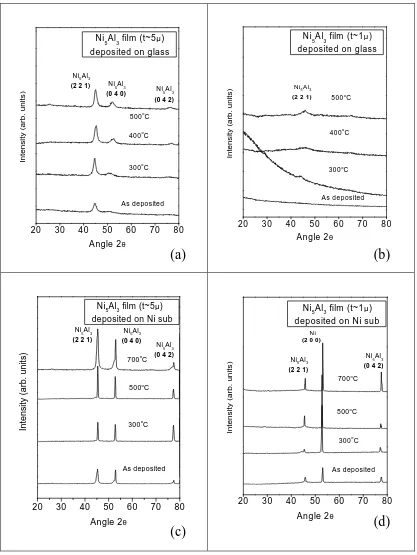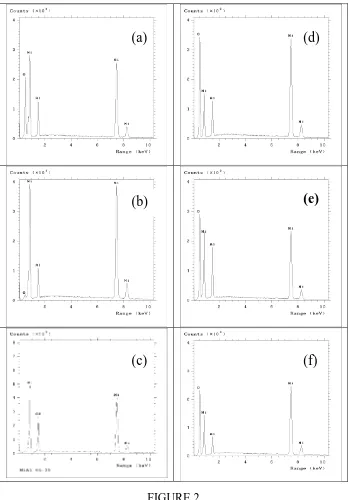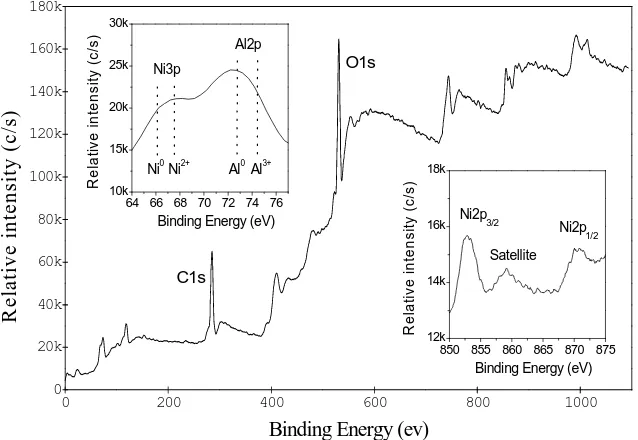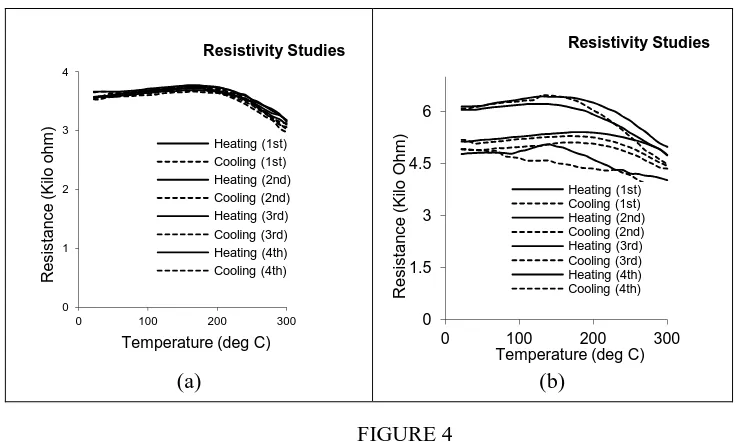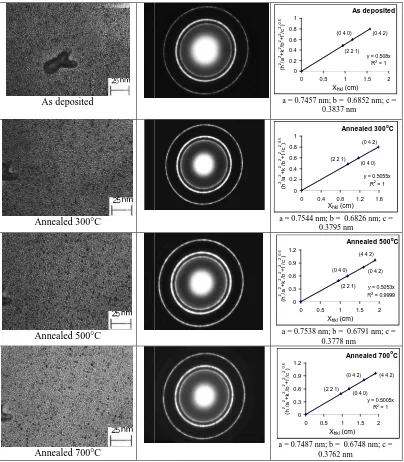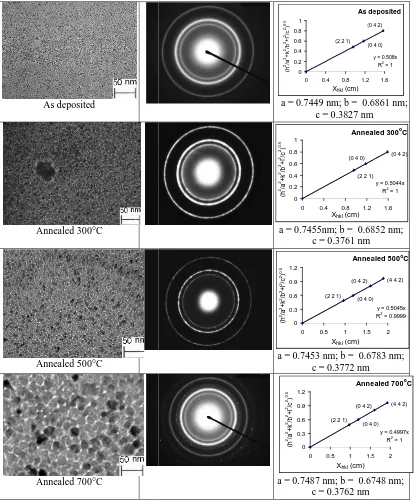ISSN: 2180-1053 Vol. 2 No. 1 January – June 2010 25
Microstructural Analysis of Intermetallic Ni
5Al
3Thin Films
T. Joseph Sahaya Anand1, A.H.W. Ngan2
1
Faculty of Manufacturing Engineering, Universiti Teknikal Malaysia Melaka, Locked Bag 1752, Pejabat Pos Durian Tunggal, 76109 Durian Tunggal, Melaka,
Malaysia.
2
Department of Mechanical Engineering, University of Hong Kong, Pok Fu Lam Road, Hong Kong.
ABSTRACT
The possible magnetic transition phenomenon obtained is postulated particularly on the Nickel Aluminum (Ni5Al3) thin films of different
thickness. It was found that the film resistance exhibits a linear but mild increase over the initial temperature range, followed by a transition to a relatively rapid decline in the resistance after attaining maximum at ~170ºC. This positive temperature coefficient of resistance (TCR) makes this material suitable for magneto resistor applications. The same observations were made on two different sputtering systems with different deposition conditions, indicating that the magnetic transition is a highly reproducible phenomenon.
KEYWORDS: Magnetic transition, Alloys, Sputtering, Resistivity,
PTC Thermistor,Nanocrystalline.
1.0 INTRODUCTION
Microstructural Analysis of Intermetallic Ni5Al3 Thin Films
ISSN: 2180-1053 Vol. 2 No. 1 January – June 2010 26 transition occurs is called the Curie temperature, or sometimes referred as the magnetic transition temperature.
There are some physical properties that will change at the instance the transition occurs: linear expansion coefficient and specific heat capacity are two of them. They normally show a discontinuity (narrow sharp peak) across Tc, and return to their
original values afterwards. Besides a magnetic disorder, it seems to be that there are no other physical properties that will change drastically for general materials beyond their Curie temperatures. Recently FM-PM transition has been under substantial research on a range of magnetic thin film materials, including La0.67Ca0.33MnO3
(LCMO), La1-xSrxMnO3 (LSMOP) and La1-xSrxCoO3 (LSCO) (Miao et al., 2008),
(Gaur and Varma, 2008), (Grishin et al., 1999), (Khartsev et al., 2000), which find potential applications in electronics. This range of materials exhibits a “colossal” magnetoresistance effect that behaves interactively with their FM-PM transitions. Also polycrystalline BaTiO3 and (Sr1-xPbx) TiO3 ferroelectric materials
(NTC-PTC-NTC) as temperature increases (Huo and Qu, 2006, Lu and Tseng, 1998, Han et al., 2007, Zhao et al., 2001, Li et al., 2009, Shahrani and Abboudy, 2000). One of the potential explanations could be the effect of ferroelectricity or ferromagnetism-both phenomena that have been identified to be the origin of the reported temperature-coefficient-of-resistance (TCR) transitions in the above mentioned oxide materials.
This paper reports a magnetic anomaly observed on Ni5Al3 alloy thin films. Ni-Al
coatings with a 3:1 stoichiometry that have been investigated in our previous work (Ng and Ngan, 2000) on conducting metal (Ni) substrates. Although the Ni-Al alloy films confirm to a normal metallic conductivity when either in its single phase or the thickness is well above 1 micron an abnormally high electrical resistance is exhibited at room temperature. It is observed when the film is thinner than a few hundred nanometers. The electrical resistance reduced drastically, when the film is heated up. The aim of the present work is to characterize the positive temperature coefficient of resistance (PTCR) in the Ni5Al3 alloy films.
2.0 EXPERIMENTAL DETAILS
The Ni5Al3 alloys for use as sputtering targets were prepared by casting
ISSN: 2180-1053 Vol. 2 No. 1 January – June 2010 27 Pre-sputtering of the target was performed at least three times with duration of 10 minutes each time, followed by flushing with high-purity argon to remove excess oxygen and other residual gases. Polished pure nickel plates with size 15 mm × 10 mm × 1 mm were used as substrates in most cases. In few cases, glass micro-slides or silicon wafers with similar dimensions were also used as substrates for compositional analyses by energy dispersive X-ray (EDX). The change of the substrate to glass or Si was to avoid signals from an otherwise Ni substrate to confuse with signals from the film itself. Prior to depositions, all the substrates were cleaned thoroughly by chemical and mechanical means to remove any organic contaminations on the surfaces. The Ni5Al3 alloy films were deposited at a
sputtering power of 30 W and the alloy target was placed 60 mm above the substrate stage. Although there was no additional thermal source applied to the substrates during the deposition process, the substrates became warmed and were heated up nearly 60ºC due to the plasma-discharge heating. The deposition rate was measured to be approximately 2 – 3 Å/sec and the film thickness was controlled by means of deposition time.
Apart from the BAL-TEC MED 020 system in Hong Kong, films with the same compositional range were also prepared by a similar dc magnetron sputterer (JCK-500A) located at Nanjing University. In the Nanjing system, the working argon was introduced at 1 x 10-2 mbar after the residual gas pressure was pumped down to 2 x 10-5 mbar. The sputtering conditions were set at 60 watt, bias of 350 V and room temperature.
X-ray analyses of the films were conducted using a Siemens diffractometer with a CuKα target operating at 40 kV / 20 mA. To determine the film thickness, a special batch of nickel substrates was prepared with notches on the back and was fractured after deposition. The compositions of the Ni-Al thin films were determined by energy dispersive X-ray analyses (EDX). These results were also confirmed by wavelength dispersive analyses (WDS) in an electrical probe (JEOL JXA-8800). The surface chemistry of the films was analyzed by X-ray photoelectron spectroscopy (XPS) performed in a 300 W ESCALAB mk-II XPS spectrometer using an Al/Mg anode.
Microstructural Analysis of Intermetallic Ni5Al3 Thin Films
ISSN: 2180-1053 Vol. 2 No. 1 January – June 2010 28 Microstructural examination was carried out in a JEOL 2000-FX TEM operating at 200 kV as well as a Philips Tecnai TEM. It is very essential that the sample to be thin enough for the electrons to penetrate. For instance, it should not be thicker than 200nm, for a TEM having an electron gun of 200kV. The crystal structures of the films were analyzed by selected area diffraction (SAD). In situ annealing inside the TEM was carried out on as-deposited films to study the microstructural changes during heating. Post-deposition heat treatment of the films was carried out with a Carbolite vacuum furnace at a vacuum of about 1 × 10-6 mbar for 2 hours followed by furnace cool to enhance their crystallinity in the TEM for comparison purposes.
3.0 RESULTS
3.1 Structural and Compositional Characterization
The X-ray spectra of the as-deposited and annealed Ni5Al3 films on both glass
microslides and nickel substrates are shown in Figure 1 (a-d). In the thicker films (~5 µm thick), peaks corresponding to the Ni5Al3 phase with an orthorhombic
structure (Khadkikar and Vedula, 1987), which consists of four differently ordered f.c.c. unit cells, can be identified from the X-ray spectra. The presence of the Ni5Al3
Microstructural Analysis of Intermetallic Ni5Al3 Thin Films
ISSN: 2180-1053 Vol. 2 No. 1 January – June 2010 30 TABLE 1
Theoretical XRD lattice parameters of Ni5Al3 phases with λ = 0.1542 nm with the
comparison data of Ni phase.
System d (nm) Angle (2θ) Intensity (h k l) abundance of nickel and aluminum in the sputtered Ni5Al3 thin films. The results in
Table 2 show that the Ni and Al compositions of the films essentially comply with the range over which the corresponding intermetallic Ni5Al3 compounds would exist.
It can be seen that the EDX and WDS results agree very well with one another.
TABLE 2
Compositional analysis of Ni-Al alloy films by EDX and WDS.
Nominal composition
Relative compositions of Ni5Al3 thin films
ISSN: 2180-1053 Vol. 2 No. 1 January – June 2010 31 EDX spectra of the Ni5Al3 thin films with pure Ni5Al3 alloy target for comparison. It
can be seen that remarkable oxygen peaks were detected mainly in the high-thickness, as-deposited films in the all compositions. But there was no significant amount of oxygen incorporated in the target materials as shown in Figure 2(c). This suggested that oxygen was incorporated into the film during sputtering. Unfortunately, owing to the limitation of the EDX quantitative analysis system, quantification of the composition for elements with atomic number smaller than 12 cannot be done. Alternatively, we can simply estimate the oxygen content by comparing the area under the oxygen peak with others, say, the Ni peak. The comparison shows that the oxygen content in the films is fairly constant.
A significant amount of oxygen (12 at. %) was observed in the as-deposited state but the oxygen content significantly reduced to 3.1 at. % after annealing at 500°C. The thicker film in Figure 2 (c) had even higher oxygen content of 29–34 at. % in the as-deposited state, but again the oxygen content reduced significantly after annealing at 300°C and 500°C for 2 hours. The oxygen content reduced from 30 to 17 at. % after annealing at 500°C.
Microstr
ISSN: 2180-1053 Vol. 2
EDX spectra collected for Ni5Al3 th
approx. 230 nm (a) as deposited and high thickness > than 1 µm (d) as de
The oxygen content was also o (XPS) analyses. Figure 3 represen Ni5Al3 film. The binding energies
ostructural Analysis of Intermetallic Ni5Al3 Thin
. 2 No. 1 January – June 2010 FIGURE 2
thin films coated on glass substrates with low th
nd vacuum annealed (b) 500°C with (c) Ni5Al3 tar
deposited and vacuum annealed (e) 300°C and (f) 5
observed during X-ray photoelectron spectro sents the XPS spectra obtained from the as-dep ies have been corrected for specimen charging e
(a)
(e)
(f)
(b)
(c)
(d)
hin Films
32
thickness target and
) 500°C.
ISSN: 2180-1053 Vol. 2 No. 1 January – June 2010 33 by taking the C1s reference peak at 284.4 eV (Crist, 2000). From amongst the wide scan spectra, significant oxygen contents can be identified in all the specimens according to the pronounced oxygen 1s (O1s) peak observed at about 531 eV. Finely resolved spectra (left insets) of the Ni3p and Al2p regions indicate that Ni and Al existed in both of their respective metallic and higher valence states. In all the three film compositions, metallic Al (72.7 eV) was found to exist more preferentially than Al3+ (74.3 eV for Al2O3), whereas Ni was, on the contrary, enriched in its oxidized
form especially for the Ni-rich specimens. The prevalence of Ni2+ is further illustrated by the Ni2p3/2 peak (right insets), which extends through the relevant
binding energies of metallic (852.8 eV) and oxidized (854.3 eV for NiO) nickel species. The emergence of satellite accompanying the Ni2p signal also infers the occurrence of Ni oxidants (Castle, 2002).
0 200 400 600 800 1000
850 855 860 865 870 875 12k
XPS spectra of Ni5Al3 thin films with the thickness less than 100 nm.
3.2 Electrical Resistance-Temperature Characteristics
Figure 4 (a) shows the typical resistance-temperature characteristics of the Ni5Al3
Microstructural Analysis of Intermetallic Ni5Al3 Thin Films
ISSN: 2180-1053 Vol. 2 No. 1 January – June 2010 34 profiles of the Ni5Al3 film exhibit an averaged slope of +0.001 kΩ/°C,
corresponding to a TCR of approximately +2.7×10-4/°C, whereas the subsequent negative TCR after the transition is estimated to be -2.1~2.4×10-3/°C over the range of temperature range concerned. The overall resistance of Ni5Al3 films lies in the
kilo-Ω range, which confirms the similar results obtained by the other sputterer by the positive to negative TCR transition behavior as shown in Figure 4(b).
3.3 Nano-crystalline structure by transmission electron microscope
To study the structural properties of Ni5Al3 intermetallic thin films, SEM has
inadequate capability to resolve the film microstructures with sufficient details. TEM was chosen to examine the nano-crystalline structure and internal build-up of the films to a finer extent. For this purpose, Ni5Al3 films were deposited on carbon
films supported by copper grids to produce plan-view samples thin enough for electron transmission in the TEM. To study the grain growth kinetics as a function of time and temperature, dynamic microstructural observations were carried out on the TEM specimens during a series of isothermal in situ heat treatments.
(a) (b)
FIGURE 4
The resistance-temperature plots of Ni5Al3 films on Ni under a series of heating and
cooling cycles (a) BAL-TEC MED 020 sputterer (thickness ~ 350 nm) (b) JCK-500A sputterer (thickness ~ 350 nm)
Figurer 5 and 6 show the in situ and post-deposition annealed transmission electron microscope analysis of Ni5Al3 thin films with thickness of approximately 150 nm.
ISSN: 2180-1053 Vol. 2 intermediate phase Ni5Al3, which
bulk condition, was observed thro SAD patterns and crystallographic
As deposited
Annealed 300°C
Annealed 500°C
Annealed 700°C
in situ TEM analysis of Ni corres
. 2 No. 1 January – June 2010 ich is orthorhombic and is stable below 700°C hroughout the process as shown in the correspo
hic calculations.
Ni5Al3 thin films showing the grain growth and
Microstr
TEM analysis of post deposition a
4.0 DISCUSSION
A fairly interesting observation m from positive to negative TCR in
ostructural Analysis of Intermetallic Ni5Al3 Thin
. 2 No. 1 January – June 2010
n annealed Ni0.65Al0.35 thin films and their SAD patt
ISSN: 2180-1053 Vol. 2 No. 1 January – June 2010 37 observed in the current Ni5Al3 films at 170 °C is not a unique phenomenon but has
been exhibited by some other systems including La1-xSrxMnO3 and La1-xCoxMnO3
colossal magnetoresistance materials (PTC-NTC) (Grishin et al., 1999), (Khartsev et al. 2000) and polycrystalline BaTiO3 and (Sr1-xPbx)TiO3 ferroelectric materials
(NTC-PTC-NTC) as temperature increases (Lu and Tseng, 1998), (Zhao et al., 2001), (Shahrani and Abboudy, 2000). One of the potential explanations could be the effect of ferroelectricity or ferromagnetism - both phenomena have been identified to be the origin of the reported TCR transitions in the above mentioned oxide materials. As a matter of fact, ferromagnetic properties have been found to exist in nanocrystalline intermetallic aluminides (Qin et al., 1997), (Lin et al., 2005), (Varin et al., 1999), (Shi et al., 2008), which are otherwise paramagnetic in bulk forms. Therefore, it will be of scientific interest to further investigate the magnetic properties and their correlation to the TCR transition in the Ni5Al3 films.
By referring to the switching of PTC to NTC observed in our Ni5Al3 films, it is
speculated that this can be related to a FM-PM transition as well. The magnetic properties of equilibrium Ni5Al3 are not well documented in the literature. So the
type of magnetism and at where a FM-PM transition would occur, if applicable, remains unclear. However, when prepared in form of a nanocrystalline thin film, the magnetic properties of Ni5Al3 would not essentially the same as the bulk material.
The emergence of such unexpected magnetic properties been attributed to the high surface-to-volume ratio of the nanograins, which leads to an increased chance of Ni-Ni ion coordinations where magnetic moments are originated. On the other hand, this intermetallic Ni5Al3 phase has an orthorhombic unit cell of Pt5Ga3-type with
lattice parameters a ≈ b ≈ 2c and is considered to consists of four differently ordered f.c.c unit cells. The observed lattice parameters show that ‘a’ and ‘b’ increase with increasing temperature as shown in Figure 1(c). A growth in the ‘a’ and ‘b’ directions would mean a large distortion and volume change.
From the present results we can conclude that Ni5Al3 alloy films are suitable for
thin-film magnetoresistor based shape memory alloy applications. The present Ni-Al film offers a range of desirable properties as a magnetoresistor material. First of all, the positive TCR characteristics of the Ni5Al3 films, including the electrical
resistance and conduction activation energy, are modifiable by annealing or control of film thickness. Accordingly, magnetoresistors with specific conductive sensitivities could be readily produced via suitable process control.
5.0 CONCLUSIONS
The thermal variations of magnetic cum electrical resistance of a range of Ni5Al3
Microstructural Analysis of Intermetallic Ni5Al3 Thin Films
ISSN: 2180-1053 Vol. 2 No. 1 January – June 2010 38 and the results were nearly the same. This proves that the positive TCR transition is characteristic of the Ni5Al3 alloy system in the thin-film state. These films are good
candidate materials for applications as positive TCR magnetoresistor based shape memory alloys, with sensitivity tunable by annealing or thickness control.
6.0 REFERENCES
A. Gaur and G.D. Varma. 2008. Journal of Alloys and Compounds, 453 pp. 423-427.
A.M.Grishin, S.I. Khartsev, and P. Johnsson, 1999. Appl. Phys. Lett., 74 pp. 1015-1017.
A.A.Shahrani and S. Abboudy. 2000. J. Phys. Chem. Solids. 61 pp. 955-959.
A. Wolkenberg and T. Przesławski. 2006. Sensors and Actuators A 126 pp. 292– 299.
B.V. Crist. 2000. Handbook of Monochromatic XPS Spectra: The Elements and Native Oxides, John Wiley & Sons.
D. Lin, J. Hu and D. Jiang. 2005. Intermetallics, 13 pp. 343-349.
H.P. Ng and A.H.W. Ngan. 2000. J. Appl. Phys., 88 pp. 2609 – 2616.
H. Shi, D. Guo and Y. Ouyang. 2008. J. of Alloys and Compounds, 455 pp. 207-209.
J.E. Castle. 2002. Surf. Interface Anal. 33. pp. 196-202.
J.H. Miao, S.L. Yuan, L. Yuan, G.M. Ren, X. Xiao, G.Q. Yu, Y.Q. Wang and S.Y. Yin. 2008. Mater. Res. Bull., 43 pp. 631-638.
J. Zhao, L. Li and Z. Gui. 2001. Sensors and Actuators A, 95 pp. 46-50.
Khartsev, S.I., Johnsson, P. and Grishin, A.M. 2000. J. Appl. Phys., 87 pp. 2394-2399.
M.Vopálenský, P. Ripka and A. Platil. 2003. Sensors and Actuators A 106 pp. 38– 42.
ISSN: 2180-1053 Vol. 2 No. 1 January – June 2010 39 P. Khadkikar and K. Vedula. 1987. compiled by JCPDS, file No. 40 – 1157. J. Mater. Res., 2. pp. 163.
R. A. Varin, J. Bystrzycki and A. Calka. 1999, Intermetallics, 7 pp. 917-930.
W. Huo and Y. Qu. 2006. Sensors and Actuators A, 128 pp. 265-269.
W.H. Han, X.K. Chen, E.Q. Xie, G. Wu, J.P. Yang, R. Wang, S.Z. Cao and Y.L. Wang. 2007. Surface Coating Technology, 201 pp. 5680-5683.
W.i Li, Z. Xu, R. Chu, P. Fu and J. Hao. 2009. J. of Alloys and Compounds. 482 pp. 137-140.
X.Y. Qin, J.R. Sun and L.D. Zhang. 1997. Nanostructured Materials, 9 pp. 623-626.
Y.L. Chan, K.W.K. Yeung, W.W. Lu, A.H.W. Ngan, K.D.K. Luk, D. Chan, S.L. Wu, X.M. Liu, Paul K. Chu and K.M.C. Cheung. 2007. Nucl. Instr. and Meth. in Phys. Res. B 257, pp. 687–691.
Y.L. Chan, S.L. Wu, X.M. Liu, Paul K. Chu, K.W.K. Yeung, W.W. Lu, A.H.W. Ngan, K.D.K. Luk, D. Chan and K.M.C. Cheung. 2007. Surf. Coat. Technol. 202, pp. 1308–1312.
